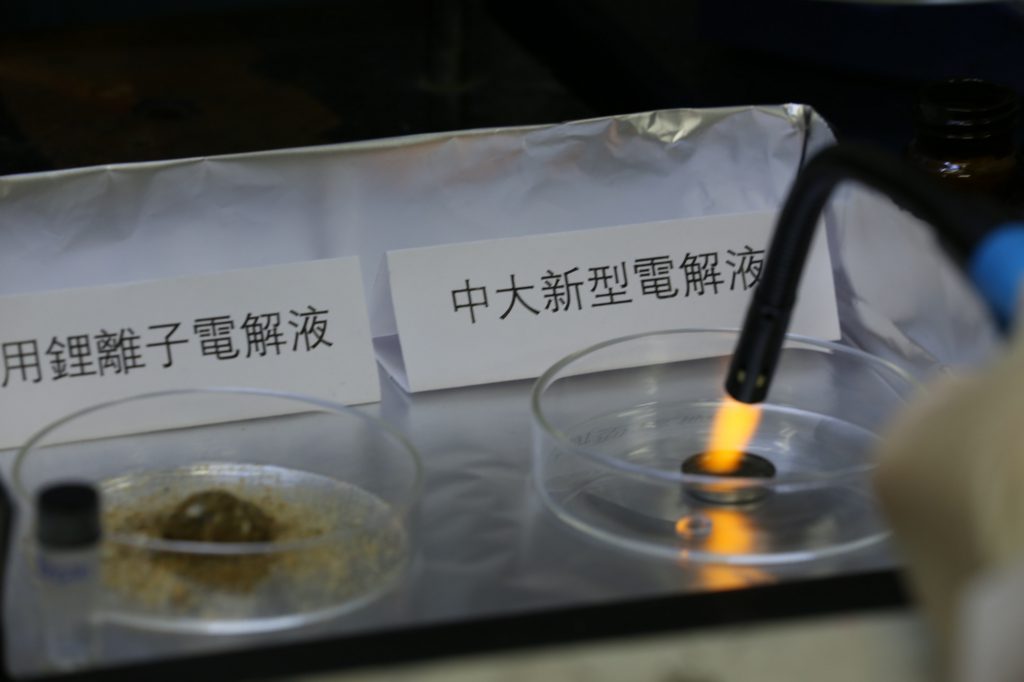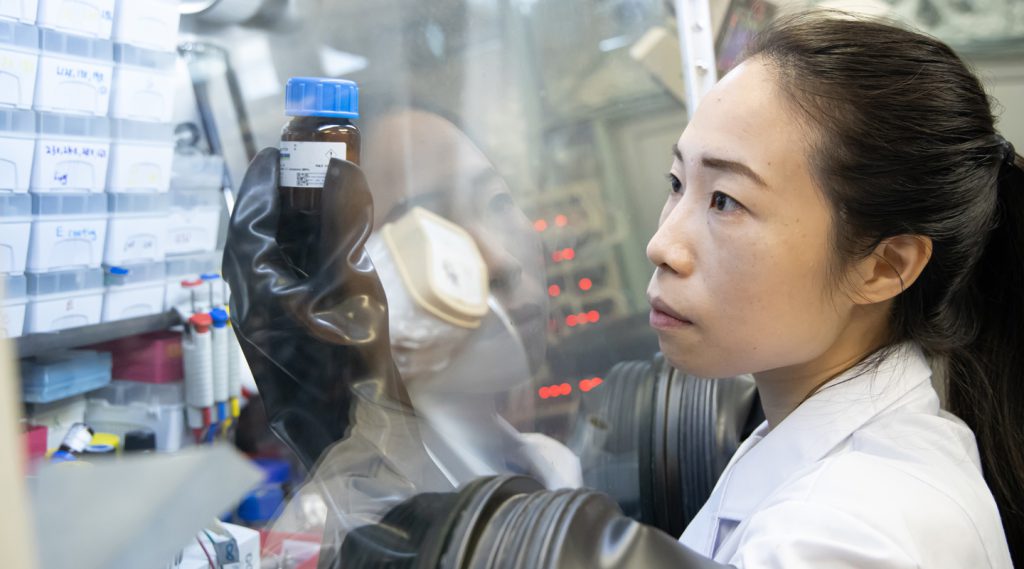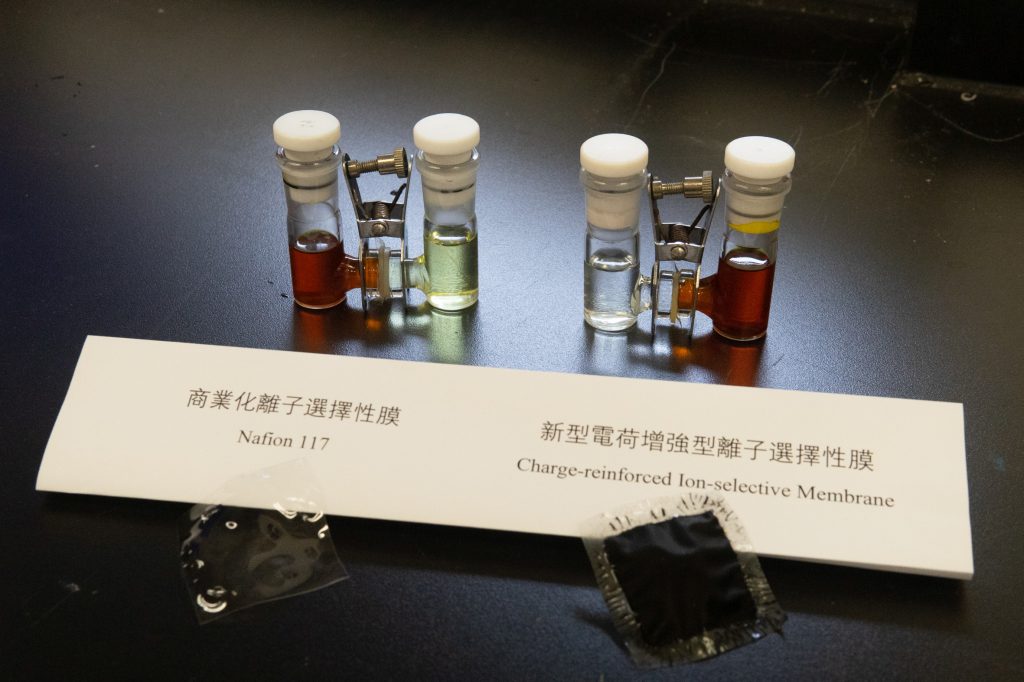Powering the world with greener, safer batteries
Powering the world with greener, safer batteries
As we move towards a sustainable future, battery storage plays a crucial role in ensuring a stable supply of renewable energy. Unfortunately, though, existing battery technologies are far from satisfactory in terms of cost, environmental friendliness, safety and stability. Professor Lu Yi-Chun is fixing that by using new materials to develop batteries that are safe, cheap and environmentally friendly. They include a novel aqueous electrolyte that removes toxic and flammable risks from lithium-ion batteries, and a sulphur-based redox flow battery for industrial use.

The novel water-based electrolyte reduces the toxicity and flammability of lithium-ion batteries and takes energy storage technology to the next level. The conventional aqueous electrolytes shown on the left in the image are burnt; the novel water-based electrolyte on the right withstands high temperatures.
Finding the secret ingredient for next-generation batteries – in skin cream
As most people know, lithium-ion batteries are prohibited in a plane traveller’s checked baggage. What fewer people know is why: because the electrolyte of these batteries is highly flammable and can explode in case of a short circuit or overheating. Professor Lu’s research team has developed an aqueous lithium-ion battery that eliminates the hazard and can even withstand heat from an open flame.
The anode, cathode and electrolyte are not only the three major irreplaceable components of a battery, but their materials and chemical compositions also hold the key to the future of battery technology. “The electrolyte inside a lithium-ion battery is composed of Li-ion salts and organic solvents, which are highly flammable and harmful to the environment,” explained Professor Lu. “But using water as the major component of the electrolyte makes it non-flammable, inexpensive and eco-friendly.”
However, when electrical current passes through water, electrolysis occurs and breaks down water into hydrogen and oxygen, destabilising the battery. Researchers used to add a large amount of Li-ion salts to counteract the reaction, but that’s expensive and uses toxic materials.

Specialising in green technology, Professor Lu uses new materials to develop safe, inexpensive, environmentally friendly energy storage systems.
After years of research, Professor Lu discovered the answer in an unexpected place: the sort of skin cream that people use everyday. Polyethylene glycol (PEG) is a safe , eco-friendly, waxy solid that is used extensively in the cosmetics industry. This water-soluble compound can induce hydrogen bonding and trigger the biological phenomenon of molecular crowding, altering and suppressing water dynamics of the aqueous electrolyte without changing its non-flammable and non-toxic features. Professor Lu’s study showed that PEG can enhance electrolyte performance in the absence of a large amount of Li-ion salts. The battery output can be maintained at 2.4 volts after several hundred charge cycles. Furthermore, PEG is only a tenth of the cost of Li-ion salts.
This finding made big waves in academia and brought Professor Lu various accolades. She believes that it can help build a more sustainable world. “We have mastered the production of aqueous batteries in the laboratory, and next we will work on further enhancing their energy capacity and power. Looking into the future, it is important to collaborate with industry, including battery and electric vehicle manufacturers, to explore real-life applications and areas for improvement.”
Professor Lu partnered with her PhD students to set up a startup company in 2021, with the support of CUHK and the government, so they can translate their research into innovative applications.
Flow battery breakthrough enables renewable energy applications
In addition to aqueous batteries, Professor Lu’s startup team has also developed a prototype of a polysulphide flow battery. It has two core components, a power pack and an energy storage tank, which provides flexibility, as the energy capacity can be increased simply with a bigger electrolyte storage tank; with a lithium-ion battery, the only way to boost its energy capacity is to attach additional batteries or build a larger cell in the first instance. The polysulphide flow battery is a better option for installations that require large storage or discharge, such as renewable energy grids.

The new membrane technology invented by Professor Lu has been acclaimed as a significant breakthrough in the commercialisation of redox flow batteries.
“We have developed a novel charge-reinforced ion-selective (CRIS) membrane for sulphur-based redox flow batteries, which prevents polysulphide from being decomposed and drained during repeated charging,” she says. “The battery life can be improved, while the discharge time can be lengthened to dozens of hours. Batteries using a CRIS membrane have the potential to replace costly vanadium redox batteries, and can effectively solve the problem of energy storage in sizeable renewable-energy grids.”
Professor Lu’s pioneering research on CRIS membrane technology was published in 2021 by Nature Energy, a prestigious international journal, and was acclaimed as a significant breakthrough in the journey towards the commercialisation of redox flow batteries.
“I always envisage that there will be a safe, portable and environmentally friendly energy solution for the globe, helping to promote a sustainable future. This is also the power that pushes me to advance in my research field.”
— Professor Lu Yi-chun
Associate Professor, Department of Mechanical and Automation Engineering, CUHK
Research areas: Electrochemical Energy and Interfaces
Major achievements:
- XPLORER Prize by Tencent Foundation (2021)
- Top 10 winners of Falling Walls in Engineering and Technology (2020)
- China’s Excellent Young Scientists Fund (2019)





